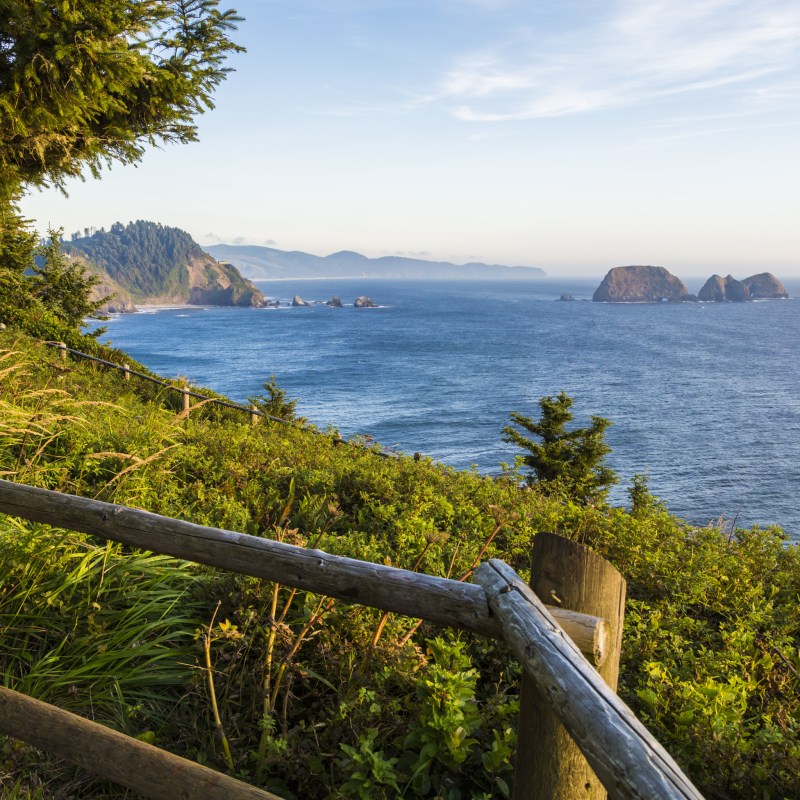
One of the most dramatic stretches of road on the Oregon coast, the 40-mile long Three Capes Scenic Loop includes practically every geologic and natural feature of the area. Connecting Cape Meares, Cape Lookout, and Cape Kiwanda, the drive showcases the finest of this stunning coast, from jagged rocks and towering sea stacks filled with seabirds, secluded beaches, and sand dunes to forests of Sitka and spruce.
Videos by TravelAwaits
The best way to experience the Scenic Loop is to use Tillamook as a gateway town. From here, watch the signs for the Three Capes Scenic Road (Road #131) off Highway 101 toward Cape Meares, the northernmost stop on the loop.
1. Explore Cape Meares
The first stop on the loop, a 700-feet-long rocky land jutting out into the ocean, Cape Meares was named after Captain Meares, the first known sea captain to sail the Tillamook Bay. On a headland over 200 feet above the ocean, Cape Meares is home to Cape Meares State Scenic Viewpoint, showcasing vertical cliffs and rocky outcroppings, covered by an old-growth forest, and the Cape Meares Wildlife Refuge, a project to preserve wildlife on the cape.
Stop at the viewpoints along the main, accessible trail and watch the largest colony of nesting seabirds on the continent. You’ll see them on Pillar Rock and Pyramid Rock, just offshore.
Looking out to the open ocean from the tip of the cape, you might see migrating gray whales along with seals and sea lions. The panoramic views of the Pacific Ocean include Three Arch Rocks and Oregon Islands National Refuge.
Take the short, quarter-mile trail to the famous Octopus Tree, an oddly shaped Sitka spruce, with several trunks growing out of its base. Extending to a circumference of over 46 feet and shooting up to about 105 feet high, the tree is believed to be about 250 to 300 years old. Protected by a short fence, it makes an interesting stop and offers a great photo opportunity.
Cape Meares is the only cape along this route with a historic lighthouse. Built in the 1890s, the lighthouse hosts free tours from May to September, where you can walk inside and learn about the harsh lives of the lighthouse keepers.
Note: Due to Covid-19 restrictions, the lighthouse stopped offering tours until further notice, but the trails are still open.

2. Spend Time On The Beach At Oceanside
Driving south on the Scenic Loop, you’ll reach Oceanside, one of the most picturesque villages on the coast, built upon the cliff overlooking the ocean. The most striking feature of the town is the beach, though, with views of the famous Three Arch Rocks out in the sea and Maxwell Point, a large rock promontory extending into the ocean.
Spend some quiet time on the beach, or cross the tunnel through Maxwell Point into Tunnel Beach, a narrow, rocky beach perfect for tide-pooling. Look out to the ocean to the Three Arch Rocks Wildlife Refuge, comprising three large and six smaller rocks, one of the Oregon coast’s best-known landmarks. The refuge protects thousands of nesting seabirds, the endangered steller sea lions, and harbor seals.
Pro Tip: Always watch the tide, especially around Maxwell Point. The difference between low tide and high tide is dramatic; you can walk around the point during low tide but need to use the tunnel during high tide. Still, don’t use the tunnel on very rainy days — you’ll see signs to stop you from entering it — since rocks might fall inside it.

3. Stop At Netarts Bay
Driving just a few miles south, you’ll reach Netarts Bay and the quaint fishing community of Netarts. Once the Tillamook Native tribe’s earliest known settlement, the name Netarts means “near the water.” Take a stroll on the quiet, sandy beach, separated by the town by a narrow stretch of forest called Netarts Spit.
Eat lunch at the Schooner, right by the fishing boat launch, with a view of the ocean. The oysters and seafood are sourced right on the bay, and their vegetables are locally grown.

4. Explore Cape Lookout State Park
Cape Lookout State Park is a popular day-use and camping area on a sand spit between Netarts Bay and the ocean.
5. Hike To The Edge Of Cape Lookout
Further along the road, you’ll find a shaded parking spot, the trailhead for the hike out to the edge of Cape Lookout. At this trailhead, you have three choices: hike out to the viewpoint, descend to a secluded beach at the southern edge of the cape, or walk back north to the park’s popular picnic and camping area. To hike out to the cape’s edge, take the left-hand trail from the parking lot, and keep straight at the first junction.
A 4.8-mile roundtrip, the hike takes you through a dense forest. You’ll have a few viewpoints along the trail. On a clear day, you can see Haystack Rock in Cape Kiwanda from the first viewpoint, about 0.6 miles from the trailhead. The next viewpoint, another half-mile later, offers a view to the north, where you can see the Three Arch Rocks. At the tip of the cape, you are about 400 feet above the ocean, with views all around. It’s also a great spot to look for migrating whales.
6. Enjoy Nature At Whalen Island And The Sand Lake Estuary
One of the most pristine estuaries on the Oregon Coast, the Sand Lake Estuary is home to many waterfowl species and offers opportunities for birdwatching, wildlife viewing, and hiking. The best way to experience it is at the Clay Myers State Natural Area at Whalen Island, an Oregon state park with a few hiking trails and picnic areas with toilets. Take the 1.4-mile-long, easy Whalen Island Trail and walk through grasslands, mudflats, sandy beaches, coastal forest, and sand dunes, all within this short distance. You can reach Whalen Island off Sandlake Road.

7. Play In The Sand At Sand Lake Dunes Recreation Area
After the quiet of the estuary, the adjacent Sand Lake Dunes Recreation Area will feel very noisy. Covering over 1,000 acres of sand dunes, it is a popular place for off-road vehicle rides in the sand. You can find plenty of rental places if you’d like to try it. Even if you are not a fan of them, stop here and take a walk among the sand dunes for the spectacular views of Cape Lookout and the Sand Lake Estuary.

8. Explore The Beach At Cape Kiwanda
The last stop on the scenic loop, the third and smallest of the capes, Cape Kiwanda, is home to the largest monolith sea-stack rock on the West Coast. Known as Haystack Rock, locals call it Chief Kiawanda Rock after the leader of the Nestucca tribe who lived in the area until the 1800s. (The spelling for the cape changed over time, but not for the rock). Now home to the Cape Kiwanda State Natural Area, the cape is worth a longer stop.
One of the most striking features of the park is the huge sand dune towering over the beach. You can hike up on it as far as you feel comfortable and enjoy the deep sand in your toes. If you walk up to the top, you are rewarded with some of the area’s most gorgeous views. Close to the edge, you’ll notice some cliffside areas fenced off; don’t cross the fence line because beyond it, the cliff edge can crumble without warning.
Or skip the hike in the sand and enjoy the beach in its shadow. The sand dune is a popular area for hang gliders — you can watch them take off from there. Close to sunset, you can watch the dory boats come onto the beach. The beach is home to the largest dory boat fleet on the coast, so you have a good chance of seeing at least one while there. (Dory boats are boats with a flat bottom to slide out onto the beach.)
Before leaving, dine at the Pelican Brewing Company and watch the sunset over Chief Kiawanda Rock.
To return to Tillamook, take 101 north past Cape Kiwanda.
Pro Tip: You can also drive the loop in the opposite direction — south to north — using Pacific City, a few miles south of Cape Kiwanda, as your gateway city. Or, rent an Airbnb in Oceanside on the hill overlooking the ocean for some of the best sunset and moonrise views over the Pacific right from your window or balcony.
Related articles:
